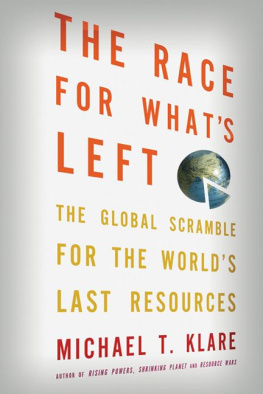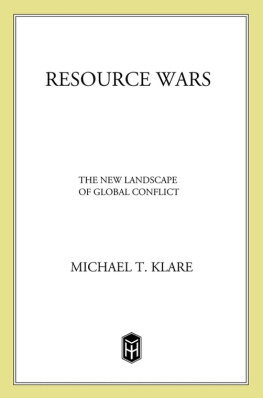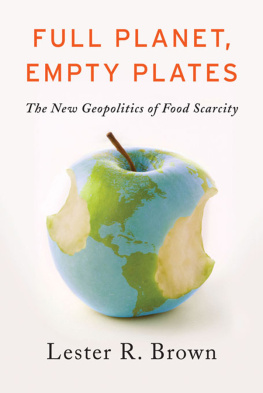Introduction
At 1:36 p.m. Moscow time on August 2, 2007, the robotic arm of a Russian mini-submarine planted a titanium replica of the Russian flag on the seabed of the North Pole, two and half miles below the oceans surface. Why did we place it? asked Artur Chilingarov, the leader of the Russian expedition. Well, any time a country wins something, it installs its flag. Explorers throughout history have planted their nations banners at prominent locations such as the South Pole and the top of Mount Everest, he explained, so the Russian teamthe first to reach the polar floorwas resolved to do likewise. Im proud the Russian flag is there, said Chilingarov. If a hundred or a thousand years from now someone goes down to where we were, they will see the Russian flag.
Chilingarov and his fellow crew members took substantial risks in piloting their vessel to the North Pole floor. Even in the middle of summer the polar ice cap is many feet thick, and the only way for the expeditions small submersible to enter the waterand to return to the surface when the dive had been completedwas to find a natural hole in the drifting ice sheet. When the team located an opening and began their descent, they could not know with any certainty that they would find a similar aperture on their return. Chilingarov admits that he feared for his life, rating his chances of survival at only 30 percent. But after planting the Russian flag and spending an hour and a half exploring the seabed, the team came back to the surface and, after some frantic searching, located the necessary opening in the ice. Nine hours after starting their dive, the expedition members returned to the (relative) safety of the icebreaker Rossiya.
I am not crazy to dive there again, Chilingarov said of the 2007 polar expedition. Still, he has not been able to conceal his pride in the achievement. There have been almost 500 people in outer space; thirteen people have been on the Moon. But we were the first to travel under the North Pole.
Chilingarov, who was awarded a Hero of Russia medal for his exploits, has spent most of his life exploring the Arctic and Antarctica on behalf of Soviet and Russian state agencies. From 1979 to 1992 he was part of the USSR State Committee of Hydrometeorology, becoming its deputy chairman in 1986; after the breakup of the Soviet Union, he served on various Russian scientific bodies and in 1993 was elected to the lower house of the Duma, the Russian parliament. Although the August 2007 expedition to the North Pole was privately organized and financed, Chilingarov has consistently affirmed that he was acting as a representative of the Russian state and its people. Our main aim is to remind the whole world that Russia is a great polar and scientific research power, he said on the eve of the polar descent.
But while national pride no doubt played a major role in his decision to plant a Russian flag on the polar seabed, Chilingarov has also made it clear that the expedition was driven in large part by pragmatic considerations. Long considered a frozen wasteland with little to attract human interest, the Arctic region is now believed to harbor vast deposits of oil, natural gas, and valuable mineralsresources that will become increasingly accessible as global warming melts the polar ice cap. Even during the Soviet era, Russian leaders insisted that the portion of the Arctic Ocean bordering Russia was part of its national territory; now that climate change is making this area (and its underground riches) ever more accessible, they are reasserting these claims. Indeed, maintaining control over this vast region and extracting its material riches have been declared strategic national priorities. But to do so, Russia must first establish its rightful ownership of these offshore territories in accordance with international lawand it was to this end that Chilingarov descended to the floor of the North Pole.
Since 1982, the determination of offshore boundaries and territorial waters has been governed by the United Nations Convention on the Law of the Sea. The treaty allows each coastal nation to establish an exclusive economic zone (EEZ) extending two hundred nautical miles out from its shoreline, within which it is entitled to control the exploitation of all natural resources, including those lying beneath the ocean bottom. In addition, the convention allows a coastal state to claim ownership of its outer continental shelf, even if it extends beyond two hundred nautical miles. To acquire such rights, however, a claimant must provide scientific evidence to demonstrate that its continental shelf does, in fact, reach beyond its EEZ. For Russia to acquire legal control over a large stretch of the Arctic, therefore, it must show that its northern landmass extends to the North Pole. This, in turn, requires undersea mapping and the collection of geological samplesexactly the activities that Chilingarovs expedition was designed to undertake. We must determine the border, the most northerly of the Russian shelf, he explained on national television.
As it happens, the Chilingarov mission did not return with conclusive evidence that the polar seabeda geological feature known as the Lomonosov Ridgeis an extension of the Russian landmass. Nevertheless, Moscow insists that the Lomonosov Ridge is indeed a part of Russia and says that it will undertake additional polar surveys to establish the legitimacy of its claim. The Russians have also made it clear that they will use force, if necessary, to protect their vital interests in the region. We have immediately started the revision of our combat training programs for military units that may be deployed in the Arctic in case of a potential conflict, General Vladimir Shamanov, the head of the Defense Ministrys combat training board, said in June 2008.
Reverberations Elsewhere
Chilingarovs expedition and Russias subsequent moves to assert control over a vast slice of the Arctic produced alarm and indignation among leaders of the other Arctic nations, all of which have announced plans of their own to exploit the regions great hydrocarbon potential. Besides Russia, four nationsCanada, Greenland (administered by Denmark), Norway, and the United Statesborder the Arctic Ocean and claim significant chunks of its total expanse. And, like Russia, all four have recently taken steps to reinvigorate their claims.
The first to act was Canada, the country with the second largest Arctic coastline and long-standing Arctic interests. Scarcely had Chilingarovs mini-submarine stuck its flag into the polar seabed when Canadas foreign minister, Peter MacKay, issued a blistering response: You cant go around the world and just plant flags and say, Were claiming this territory.
Shortly after this announcement, Prime Minister Stephen Harper left for one of Canadas northernmost settlements, the frigid hamlet of Resolute Bay, located on Cornwallis Island in the Canadian Arctic Archipelago. Speaking in a storage shed to protect him from the icy, howling winds, Harper announced a series of moves aimed at bolstering Canadas strategic presence in the Arctic region. Resolute Bay itself, he indicated, would become the home of a new Canadian Army training center for cold-weather operations. In addition, the government would establish a deepwater port for military and civilian use on Baffin Island, at the eastern end of the Northwest Passage between the Atlantic and Pacific Oceans.
Russias Arctic initiatives also prompted a vigorous response from Denmark, which exercises ultimate authority over Greenland. On August 11, 2007, while Prime Minister Harper was in Resolute Bay to reassert Canadas claims to the region, a Danish scientific expedition aboard the Swedish icebreaker Oden headed into far northern waters in an attempt to collect data showing that the Lomonosov Ridge was an extension of Greenland, rather than Russia. Although the Danish mission had been planned before Chilingarov began his expedition to the ocean floor, it was now portrayed as a necessary counter to Russias territorial claims. The preliminary investigations done so far are very promising, declared Helge Sander, Denmarks minister of science, technology, and innovation, as the Oden set sail. There are things suggesting that Denmark could be given the North Pole.








